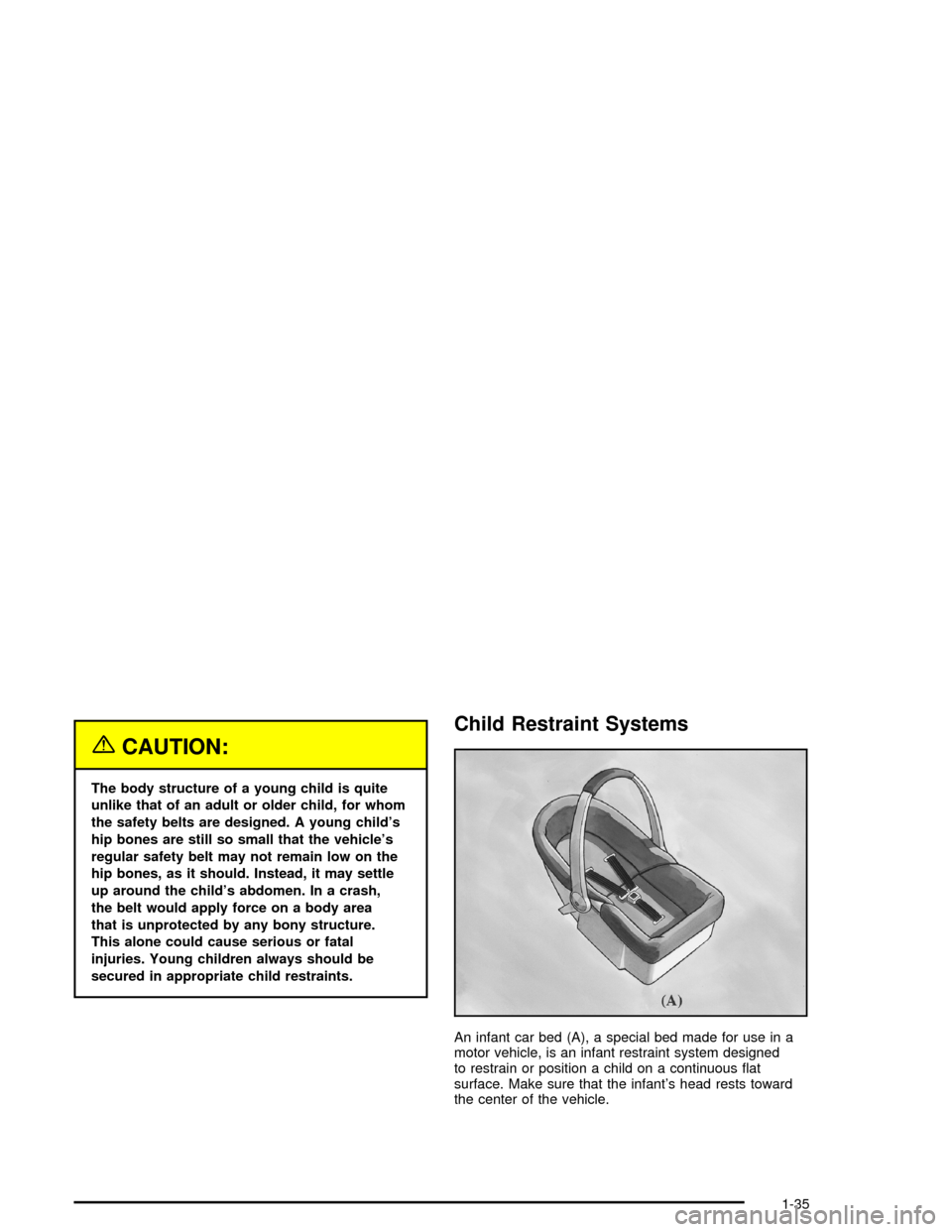tow CHEVROLET IMPALA 2005 8.G Owners Manual
[x] Cancel search | Manufacturer: CHEVROLET, Model Year: 2005, Model line: IMPALA, Model: CHEVROLET IMPALA 2005 8.GPages: 398, PDF Size: 10.04 MB
Page 1 of 398

Seats and Restraint Systems........................... 1-1
Front Seats
............................................... 1-2
Rear Seats
............................................... 1-6
Safety Belts
.............................................. 1-8
Child Restraints
.......................................1-29
Airbag System
.........................................1-49
Restraint System Check
............................1-58
Features and Controls..................................... 2-1
Keys
........................................................ 2-2
Doors and Locks
....................................... 2-8
Windows
.................................................2-12
Theft-Deterrent Systems
............................2-14
Starting and Operating Your Vehicle
...........2-16
Mirrors
....................................................2-28
OnStar
®System
......................................2-30
HomeLink®Wireless Control System
...........2-32
Storage Areas
.........................................2-36
Sunroof
..................................................2-37
Vehicle Personalization
.............................2-38
Instrument Panel............................................. 3-1
Instrument Panel Overview
.......................... 3-4
Climate Controls
......................................3-21
Warning Lights, Gages, and Indicators
........3-26
Message Center
.......................................3-40Driver Information Center (DIC)
..................3-49
Trip Computer
.........................................3-51
Audio System(s)
.......................................3-52
Driving Your Vehicle....................................... 4-1
Your Driving, the Road, and Your Vehicle
........ 4-2
Towing
...................................................4-35
Service and Appearance Care.......................... 5-1
Service
..................................................... 5-3
Fuel
......................................................... 5-5
Checking Things Under the Hood
...............5-10
Headlamp Aiming
.....................................5-54
Bulb Replacement
....................................5-54
Windshield Wiper Blade Replacement
.........5-59
Tires
......................................................5-60
Appearance Care
.....................................5-89
Vehicle Identi�cation
.................................5-98
Electrical System
......................................5-99
Capacities and Speci�cations
...................5-106
Maintenance Schedule..................................... 6-1
Maintenance Schedule
................................ 6-2
Customer Assistance and Information.............. 7-1
Customer Assistance and Information
........... 7-2
Reporting Safety Defects
...........................7-10
Index................................................................ 1
2005 Chevrolet Impala Owner ManualM
Page 9 of 398

Six-Way Power Seats
If your vehicle has this feature, the control is located on
the outboard side of the front seats. To adjust the
seat do any of the following:
Move the seat forward or rearward by sliding the
control to the front or the rear.
Raise or lower the seat by sliding the control up
or down.
Raise or lower the front portion of the seat cushion
by sliding the front of the control up or down.
Raise or lower the rear portion of the seat cushion
by sliding the rear of the control up or down.
Manual Lumbar
If your vehicle has this feature, the knob is located on
the outboard side of the driver’s seat. Turn the knob
toward the front of the vehicle to increase lumbar
support. Turn the knob toward the rear of the vehicle to
decrease lumbar support.
1-3
Page 13 of 398

To raise the rear seatback, follow these steps:
1. Raise the seatback up and make sure it latches.
2. Push and pull on the seatback to be sure it is locked
in position.
3. Ensure that the safety belts are properly stowed
over the seatback in all three positions.
{CAUTION:
A safety belt that is improperly routed, not
properly attached, or twisted will not provide
the protection needed in a crash. The person
wearing the belt could be seriously injured.
After raising the rear seatback, always check
to be sure that the safety belts are properly
routed and attached, and are not twisted.
{CAUTION:
If the seatback is not locked, it could move
forward in a sudden stop or crash. That could
cause injury to the person sitting there. Always
press rearward on the seatback to be sure it is
locked.
When the seat is not in use, it should be kept in the
upright locked position.
1-7
Page 36 of 398

{CAUTION:
Never do this.
Here two children are wearing the same belt.
The belt can not properly spread the impact
forces. In a crash, the two children can be
crushed together and seriously injured. A belt
must be used by only one person at a time.
Q:What if a child is wearing a lap-shoulder belt,
but the child is so small that the shoulder belt
is very close to the child’s face or neck?
A:If the child is sitting in a seat next to a window,
move the child toward the center of the vehicle.
If the child is sitting in the center rear seat
passenger position, move the child toward the
safety belt buckle. In either case, be sure that the
shoulder belt still is on the child’s shoulder, so
that in a crash the child’s upper body would have
the restraint that the belts provide.
If the child is sitting in a rear seat outside position,
seeRear Safety Belt Comfort Guides for Children
and Small Adults on page 1-26.
1-30
Page 41 of 398

{CAUTION:
The body structure of a young child is quite
unlike that of an adult or older child, for whom
the safety belts are designed. A young child’s
hip bones are still so small that the vehicle’s
regular safety belt may not remain low on the
hip bones, as it should. Instead, it may settle
up around the child’s abdomen. In a crash,
the belt would apply force on a body area
that is unprotected by any bony structure.
This alone could cause serious or fatal
injuries. Young children always should be
secured in appropriate child restraints.
Child Restraint Systems
An infant car bed (A), a special bed made for use in a
motor vehicle, is an infant restraint system designed
to restrain or position a child on a continuous �at
surface. Make sure that the infant’s head rests toward
the center of the vehicle.
1-35
Page 62 of 398

How Does an Airbag Restrain?
In moderate to severe frontal or near frontal collisions,
even belted occupants can contact the steering wheel or
the instrument panel. In moderate to severe side
collisions, even belted occupants can contact the inside
of the vehicle. The airbag supplements the protection
provided by safety belts. Airbags distribute the force of
the impact more evenly over the occupant’s upper body,
stopping the occupant more gradually. But the frontal
airbags would not help you in many types of collisions,
including rollovers, rear impacts, and many side impacts,
primarily because an occupant’s motion is not toward the
airbag. A side impact airbag would not help you in many
types of collisions, including frontal or near frontal
collisions, rollovers, and rear impacts, primarily because
an occupant’s motion is not toward that airbag. Airbags
should never be regarded as anything more than a
supplement to safety belts, and then only in moderate to
severe frontal or near-frontal collisions for the driver’s and
right front passenger’s frontal airbags, and only in
moderate to severe side collisions for vehicles with a
driver’s side impact airbag.
What Will You See After an Airbag
In�ates?
After the airbag in�ates, it quickly de�ates, so quickly
that some people may not even realize the airbag
in�ated. Some components of the airbag module will be
hot for a short time. These components include the
steering wheel hub for the driver’s frontal airbag and the
instrument panel for the right front passenger’s frontal
airbag. For vehicles with a driver’s side impact
airbag, the side of the seatback closest to the driver’s
door will be hot. The parts of the bag that come
into contact with you may be warm, but not too hot to
touch. There will be some smoke and dust coming from
the vents in the de�ated airbags. Airbag in�ation
does not prevent the driver from seeing or being able to
steer the vehicle, nor does it stop people from leaving
the vehicle.
1-56
Page 74 of 398

Doors and Locks
Door Locks
{CAUTION:
Unlocked doors can be dangerous.
Passengers — especially children — can
easily open the doors and fall out of a
moving vehicle. When a door is locked,
the handle will not open it. You increase
the chance of being thrown out of the
vehicle in a crash if the doors are not
locked. So, wear safety belts properly and
lock the doors whenever you drive.
Young children who get into unlocked
vehicles may be unable to get out. A child
can be overcome by extreme heat and can
suffer permanent injuries or even death
from heat stroke. Always lock your vehicle
whenever you leave it.
Outsiders can easily enter through an
unlocked door when you slow down or
stop your vehicle. Locking your doors can
help prevent this from happening.There are several ways to lock and unlock your vehicle.
From the outside, use your key or remote keyless
entry transmitter. From the inside, use the manual or
power door locks.
To unlock the driver’s side door from the outside with
the key, insert the key and turn it toward the front of the
vehicle. To lock the driver’s side door from the outside
with your key, insert the key and turn it toward the
rear of the vehicle.
To lock the door from the inside, push the manual lock
lever forward. To unlock the door, pull the lever rearward.
2-8
Page 82 of 398

Starting and Operating Your
Vehicle
New Vehicle Break-In
Notice:Your vehicle does not need an elaborate
break-in. But it will perform better in the long run if
you follow these guidelines:
Do not drive at any one speed, fast or slow,
for the �rst 500 miles (805 km). Do not make
full-throttle starts.
Avoid making hard stops for the �rst 200 miles
(322 km) or so. During this time your new brake
linings are not yet broken in. Hard stops with new
linings can mean premature wear and earlier
replacement. Follow this breaking-in guideline
every time you get new brake linings.
Do not tow a trailer during break-in. SeeTowing a
Trailer on page 4-37for more information.
Ignition Positions
With the key in the ignition, you can turn the switch to
four positions.
The ignition switch is
located on the steering
column.
OFF:This position locks your steering column in a
vehicle with a manual transmission. It is a theft-deterrent
feature. You will only be able to remove your key
when the ignition is turned to OFF.
Notice:Using a tool to force the key from the
ignition switch could cause damage or break the
key. Use the correct key and turn the key only with
your hand. Make sure the key is all the way in.
If it is, turn the steering wheel left and right while
you turn the key hard. If none of this works,
then your vehicle needs service.
2-16
Page 86 of 398

Automatic Transaxle Operation
Your automatic transaxle may have a shift lever on the
steering column or on the console between the seats.
There is also a display, like the graphic above, located
on the instrument panel cluster that will indicate the
gear the vehicle is in.
Maximum engine speed is limited on automatic transaxle
vehicles while you are in PARK (P) or NEUTRAL (N)
to protect driveline components from improper operation.
There are several different positions for your shift lever.
PARK (P):This position locks your front wheels. It is
the best position to use when you start your engine
because your vehicle cannot move easily.{CAUTION:
It can be dangerous to get out of your vehicle
if the shift lever is not fully in PARK (P) with
the parking brake �rmly set. Your vehicle can
roll. If you have left the engine running, the
vehicle can move suddenly. You or others
could be injured. To be sure your vehicle will
not move, even when you are on fairly level
ground, use the steps that follow. If you are
pulling a trailer, seeTowing a Trailer on
page 4-37.
Make sure the shift lever is fully in PARK (P) before
starting the engine. Your vehicle has an automatic
transaxle shift lock control system. You must fully apply
your regular brakes before you can shift from PARK (P)
while the ignition is in ON. If you cannot shift out of
PARK (P), ease pressure on the shift lever by pushing it
all the way into PARK (P) while keeping the brake
pedal pushed down. Release the shift lever button if you
have a console shift. Then move the shift lever out of
PARK (P). SeeShifting Out of Park (P) on page 2-25.
2-20
Page 87 of 398

REVERSE (R):Use this gear to back up.
Notice:Shifting to REVERSE (R) while your vehicle
is moving forward could damage the transaxle.
The repairs would not be covered by your warranty.
Shift to REVERSE (R) only after your vehicle is
stopped.
To rock your vehicle back and forth to get out of snow,
ice or sand without damaging your transaxle, see
If Your Vehicle is Stuck in Sand, Mud, Ice or Snow on
page 4-29.
NEUTRAL (N):In this position, your engine does not
connect with the wheels. To restart when you are
already moving, use NEUTRAL (N) only. Also, use
NEUTRAL (N) when your vehicle is being towed.
{CAUTION:
Shifting into a drive gear while your engine is
running at high speed is dangerous. Unless
your foot is �rmly on the brake pedal, your
vehicle could move very rapidly. You could
lose control and hit people or objects. Do not
shift into a drive gear while your engine is
running at high speed.Notice:Shifting out of PARK (P) or NEUTRAL (N)
while the engine is running at high speed may
damage the transaxle. The repairs would not be
covered by your warranty. Be sure the engine is not
running at high speeds when shifting your vehicle.
AUTOMATIC OVERDRIVE (D): This position is for
normal driving. If you need more power for passing, and
you are:
Going less than 35 mph (55 km/h), push your
accelerator pedal about halfway down.
Going about 35 mph (55 km/h) or more, push the
accelerator pedal all the way down.
You will shift down to the next gear and have more
power.
Notice:Driving your vehicle if you notice that it
is moving slowly or not shifting gears as you
increase speed may damage the transmission.
Have your vehicle serviced right away. You can
drive in SECOND (2) when you are driving less than
35 mph (55 km/h) and AUTOMATIC OVERDRIVE (D)
for higher speeds until then.
2-21